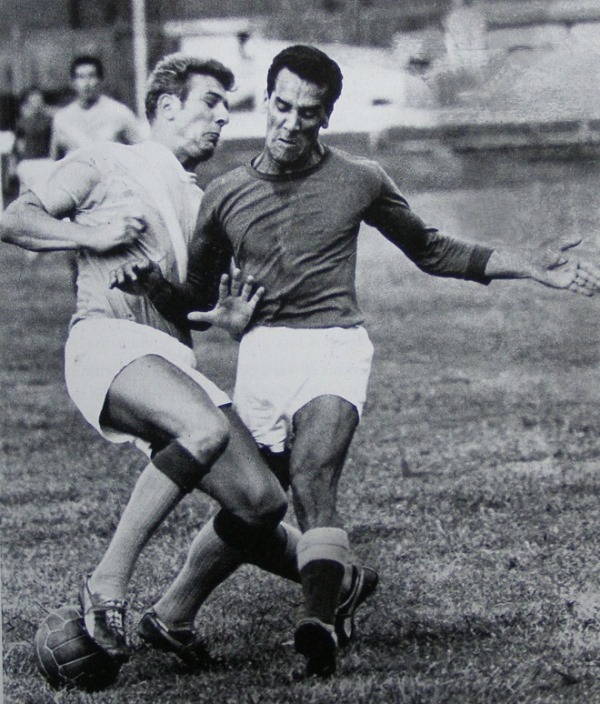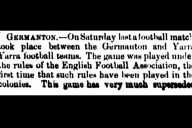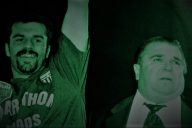In the early 1950s a young Aboriginal footballer called Charlie Perkins started to be noticed in Adelaide. John Maynard in The Aboriginal Soccer Tribe points out that “Perkins was a first grade soccer player at the age of fifteen, playing with Port Thistle.” Over the next five years his stocks improved to the point where he “was awarded the South Australian player of the Year.” He claims that “Perkins was known as one of the better wing-halves in the country.” Peter Read’s biography of Perkins describes him as “tough, self-confident, stoical and uncompromising. He liked to talk about the game for days afterwards. He was ambitious to be better than anyone else. Off the field he remained, according to the Secretary of the South Australian Soccer Federation, anxious and shy.”
It is perhaps well-known that Charlie Perkins played football, very well, playing at the elite level in Australia. He tried out for First Division clubs Liverpool and Everton in England before playing a season with Bishop Auckland, one of England’s great amateur sides. The experience helped to form his attitude towards the game: “I play the game hard, the way I was taught with Bishop Auckland in England. After all soccer is a man’s game. But I play it fair and don’t go in for the dirty, niggling tactics of some players.”
But while Perkins was a genuine star of the game he is probably remembered as a curiosity, without context, an exception that proves the rule. Perkins’ game of choice might be explained away, if explained at all, via allusion to his radical political orientation and his ‘difference’ from other Aboriginal sportsmen. The attitude adopted is: ‘Yes. He might have played football but he was a maverick.’ Well he may have been a maverick but he was not the only one.
Two other Aboriginal players of Perkins’ generation also had remarkable careers, first as footballers and then in Aboriginal culture and/or politics. John Moriarty was the first Aboriginal to be selected for Australia and Gordon Briscoe followed in Perkins’ footsteps, playing for two seasons in England. What makes this story all the more remarkable is that these three young men knew each other intimately. Gordon Briscoe’s 2010 memoir, Racial Folly: a Memoir of a Twentieth Century Family is a startling revelation of locus of Aboriginal participation in the world game. It is a locus confirmed by Maynard. The story of Briscoe’s life from his birth in 1938 to his rise to prominence as an activist and the struggles, sadnesses and joys involved in that journey, contains a remarkable diversion into an Aboriginal footballing sub-culture of mildly staggering proportions – not so much in its breadth as in its sheer depth of quality. Out of one institution, “Father Smith’s home for boys of mixed Aboriginal descent,” came a remarkable number of players.
Briscoe explains how the boys became involved.
Charlie, with his brother Ernie, John Moriarty, Jerry Hill and I, began our soccer careers together and for the same team, Port Adelaide Thistle, or Port Thistle as it became known. In 1950 Port Thistle won the second division championship and was elevated to the first division. To qualify for the promotion the club had to have teams in the lower or junior division. Port Thistle management approached Father Smith for permission to rent a large field in the front area of St Francis House owned by the Church, and he agreed. Thistles had enough boys in the area to make two teams: a full juniors’ team and a senior colts’ team. The house boys filled the junior team and Charlie, ‘Truck’ and Harry Russel made the colts. From the beginning Charlie was a natural, as were many in the junior side, particularly Moriarty (Baggy) and Hill (Skrulyet).
Significantly, all of the boys also played Australian Rules and some of them (surprisingly) Rugby League for a Semaphore Colts team. One of the boys, Wally McArthur ended up playing Rugby League for Australia. In fact the boys participated in many physical activities that strengthened their bonds. When their mentor Father Smith left, Briscoe was devastated.
What possibly helped me cope with my feeling of loss was life on Semaphore beach, enjoying activities such as fishing off the jetty with Wally MacArthur, Vince Copley, Gerry Hill and John Moriarty. Soccer with Port Thistle junior’s side also helped and would lead to a closer relationship with Charlie Perkins.
It was Perkins who influenced Briscoe and Moriarty to lean towards football:
Charlie had great talent in both codes but I believe that he chose to excel at soccer as a way of evading the bullies at the House and as a way of venting his frustrations at Father Smith’s leaving. He also resented the prejudice he confronted by those who played and organised Aussie Rules.
In his autobiography, A Bastard Like Me, Perkins describes how football hooked him.
And so, soccer got into my system. That year I played for the juniors in the Scottish Club (Port Thistle) in Adelaide. I got on well with the club crowd. They treated me like a human being. That was where I first felt free, when I began to play soccer. The team would talk roughly to me and I would know where I stood. Soccer was the only thing that enabled me to put up with my job. The Soccer Club became my home and I found a new security in my ability to play well. I found some friends in soccer. Most of all, I found a place where I could be somebody. I could play soccer better than most people and was improving all the time. I played one year junior, then senior at fifteen, and after that I played first division right through the rest of my professional soccer career.
Moriarty also speaks of culture of racism from which football helped him to extract himself. He told Maynard:
Soccer was a blessing for me, on the social side as well, being able to achieve my self-esteem, the culture of soccer enabled me to move out of that system that we were brought up in, you know, that totally racist system, being a second-class citizen and Aboriginal under differing laws and we had to live with it. But soccer lifted me out of that because the soccer fraternity encouraged me to do it.
Briscoe also was confronted with a milder form of racial prejudice as well as a touch of soccerphobia when he started a new job a Port Lincoln.
One day soon after my arrival a big bloke named Charlie Oliver jumped on the engine and said, ‘Can any of you blokes kick a footy?’ I said nothing at first but Jack Asher, the engine driver, said, ‘Hey Charlie this bloke’s a Blackfella; he must be able to play. Every Blackfella I know is football mad, and I’ve seen some beauties up at Peterborough, where I come from!’ When I told Charlie that I wanted to play soccer, he blurted out, ‘What, that’s a Sheila’s game isn’t it?’ He jumped down from the engine and shouted at me: ‘Come to training on Tuesday night! OK?’
So Briscoe played both codes at senior level. Normative, masculinised cultural pressures tended to push him towards Australian Rules whereas other factors made football an attraction.
When I went to Souths I knew many of the white players who worked for the railway and got on well with them. I was certainly more interested in girls and I was particularly interested in the migrant women who followed soccer. My weekends were busy; I played cricket or Aussie Rules on Saturdays and soccer on Sundays. Nevertheless work dominated my life and I often had to struggle to get back for the weekends.
Eventually he made the decision to focus on football. Perkins’ return from playing in England may have been an influence and perhaps he sensed that he had a future in the game. The fact that he was paid for scoring goals probably influenced the decision.
I played my last Aussie Rules game for Exeter in the 1959 grand final and subsequently returned to soccer. John Moriarty and I signed to play soccer for Beograd in the summer-night football season. These matches were played under lights at Norwood Oval. Charlie Perkins had recently returned from England and was instrumental in taking Croatia to the first Division and enticed me to play the winter season with them.
“In the winter of 1960” a new influence emerged in Briscoe’s life: “Aboriginal politics and soccer were my passions.”
Briscoe steadily improved as a player. He moved from Croatia to Polonia before deciding to try his luck in England – perhaps once more influenced by the example of Perkins’ experience. After playing with Hemel Hempstead and Preston North End’s lower grades Briscoe suffered injuries and started to suspect that he did not have what was needed to make the grade in professional football in England.
As the winter drew on I became more and more fearful that I would injure myself; my confidence was plummeting. I stuck it out in Hemel for that winter and moved to Preston in mid-1962. However, one aspect of Hemel Hempstead that would have a profound effect on my life was meeting Norma, my wife to be, at a local dance hall. We met early in 1962 and were married in the autumn of that year.
At this point in the narrative, the game recedes from view and Briscoe gets a job in factory before returning to Australia with Norma and his 12-month-old baby Aaron in 1964. Charlie Perkins had moved to Sydney to attend University and play with Pan Hellenic and was still there when Briscoe decided to come home. Perkins asked Briscoe to come to Sydney to participate in a new phase in their lives, Aboriginal activism.
Curiously, football then leaves Briscoe’s life and his subsequent remembrance of it. The memoir seems to drop the game like a hot potato as Briscoe’s career in politics ramps up. Racial Folly offers a model here of the way the game disappears from view in so many other stories in Australian history. Briscoe says in his Foreword to Maynard’s The Aboriginal Soccer Tribe, “soccer could not support a wife and family so the alternative was work by day and study by night. I was drawn into Aboriginal politics in the same way as Perkins and Moriarty.”
This necessity does not explain the near-complete cutting of football from the narrative of Racial Folly. Even if the game were practically absent from Briscoe’s life, it would have been with his thoughts and a subject of discussion from time to time, especially when he was so closely connected with Perkins. Football makes a late comeback in Racial Folly when it is mentioned in relation to Briscoe’s grown children who, like their father and Perkins and Moriarty before them, use sport as important building blocks for their lives:
John was an outdoors boy. He was always looking to play rugby on the front lawn with the neighbour’s kids, his elder brother Aaron or me. They were all keen sportspersons, each doing well in their respective sports. Aaron was a very good all-rounder, his main passion was soccer, which he played at an elite level with the Canberra City colts’ soccer team, and he was also a competent cricket player during the summer months. Lisa was a one-sport person – hockey. Later she played in the weekly Canberra competition, as well as being an ACT representative player for a number of years. John loved his rugby league. One of my lasting memories is standing on the side-line with John hurling down the side and the crowd calling out: ‘Go, Johnny B’. He loved it and he too was a representative player.
The Briscoe children mirror their father’s attitude to sport. They are also a reminder of the special group of young Aboriginal men in Semaphore showing a sporting flexibility that enabled them to move easily and gracefully between football codes, something that enables them to take up football but makes them equally able to leave the game when the pressures of other sports and politics come to bear. It is an important message for contemporary Indigenous participation in the game.
Briscoe claims in his Foreword to Maynard’s book that the game has “forgotten Aboriginal people in its zest for self-development.” He reminds readers that football in Port Adelaide relied on Aboriginal participation at a certain moment in time.
Individual clubs such as Port Thistle blindly supported us because, without us it would not have existed. Dominated by cricket and Australian Rules, migrants had to beg for playing space and were targeted by Australia’s press. What brought us few players to soccer was often the fact that our skills were transferred from Aussie Rules when we were driven away from that code. We chose migrants because they respected us.
It was a rare moment because a number of factors came into play in leading Aboriginal players towards football: excellent and adaptable Aboriginal sportsmen; truly remarkable individuals; generous and welcoming football hosts; and an Australian Rules structure that was often exclusive and racist towards Aboriginal players. Briscoe says that when “we look to the future of Aboriginal people in soccer it is easy to be optimistic, but . . . the time is now ripe for the FFA to provide the support and the framework in which the passionate advocates and players of Indigenous soccer can succeed.” It is a warning, gentle and well-intended, that football needs to remember the Port Thistle story. Because it is one that speaks of dire consequences should it not be heeded Australian football authorities.
Another message in Maynard’s book relates to the low Aboriginal participation rate in football. Compared with Rugby League and Australian Rules, the number is low. Yet it is not quite miniscule. Maynard lists five Aboriginal Socceroos (six if we include Moriarty who was selected but didn’t play because Australia was expelled from FIFA after his selection) and eight Matildas. He also points to a number of contemporary rising stars, both men and women. An argument could be made that this is more representation than might be expected, given the external pressures encouraging young Aboriginal men into other football codes and the near absence of historical knowledge within the game about Aboriginal precursors.
One of the most telling points of the whole book is when Harry Williams, perhaps the greatest Aboriginal player of all time (with 44 Socceroo appearances and 18 full caps), insists that what got him into the game was not the legendary stories of the trinity of “Perkins, Moriarty and Briscoe.” He knew little of them, except as political activists. Rather, his was the much less heroic but no less splendid story of being “exposed to soccer by a friend across the street at six years of age. For me, it was just a question of circumstances. It just happened.” Yet there was pressure from another football code. He grew up in Rugby League territory and the St George great and family friend, Billy Smith kept pestering him to shift codes. Smith “always said to stop playing that sissy game and come to play rugby league.” Like the trinity before him he resisted and found solace in the genuine acceptance of the migrant communities that welcomed him.
This is a good story but it is one that encodes a failure in communication between the generations. In the battle for the hearts and minds of Aboriginal sportsmen, Australian football’s silence and failure to follow through – on what can only be described as a wonderful moment in Aboriginal participation in and commitment to the game – is nothing short of criminal irresponsibility to its own wellbeing.
Australian football needs to confront the fact that at one point in the 1950s there were more Indigenous Australians playing-grade football in Adelaide than there were playing first-grade Australian Rules in Melbourne. And while the numbers were low and volatile they nonetheless represented a march stolen on the “indigenous” game. It needs to remember why this was the case and work out how to tell the story.


















Check out Bill Murray’s response to my article here http://neososmos.blogspot.com.au/2014/01/in-their-shadows.html
Such an interesting article. I have managed to trace a copy of the book in a second hand book store at Berrima. The very helpful lady told me it has Charlie’s autograph in it.